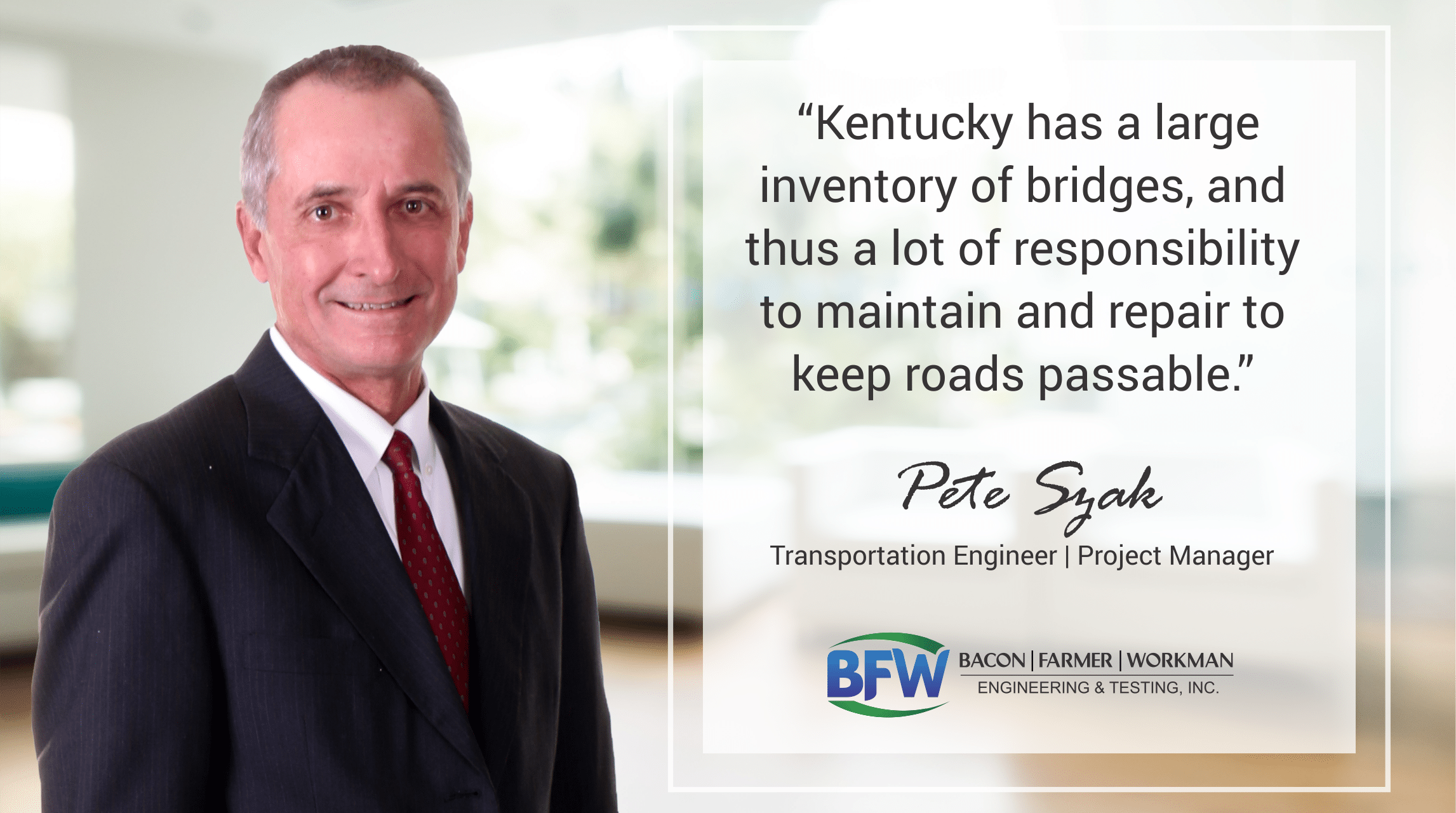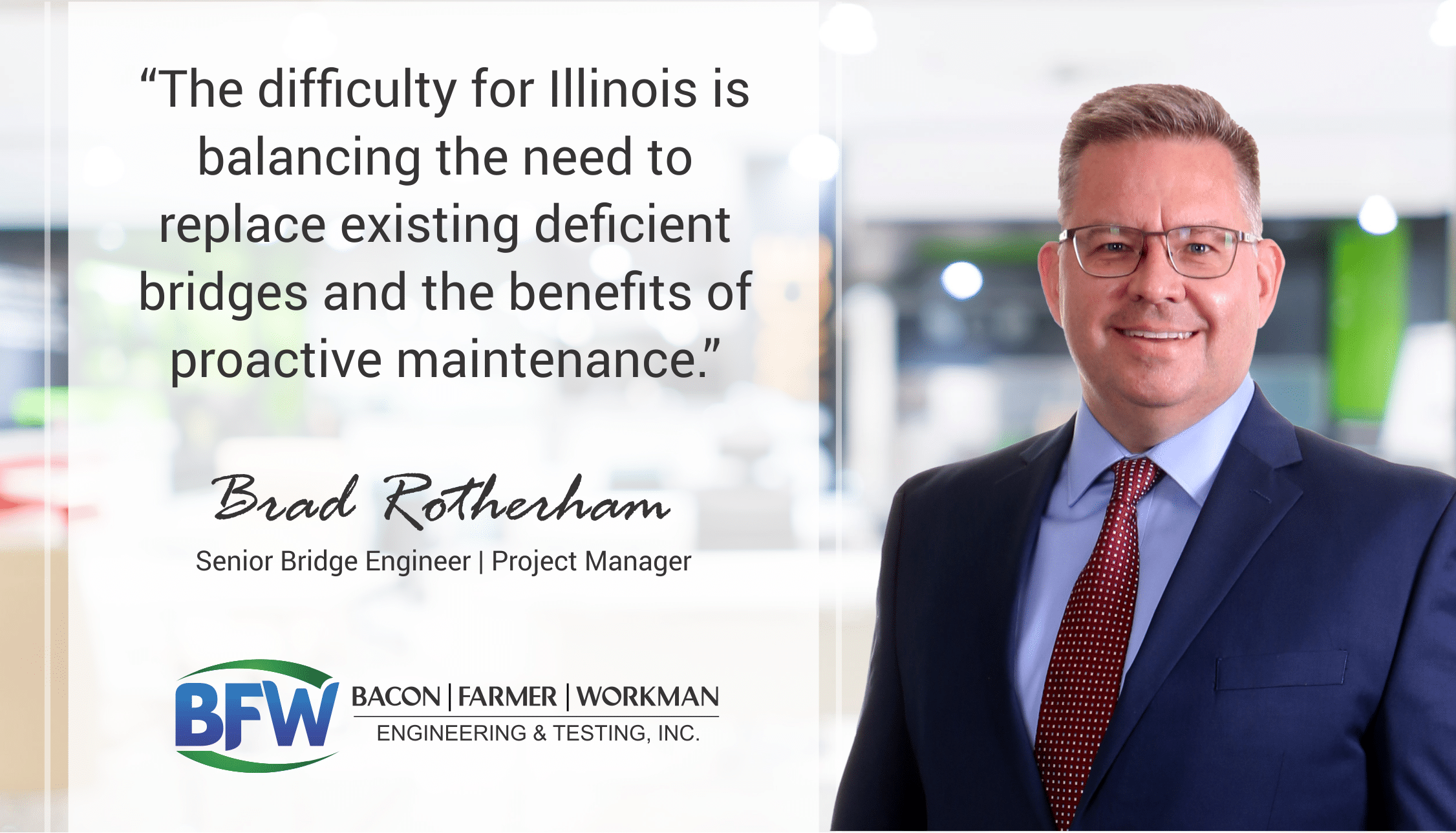On February 7, as President Joe Biden boarded Air Force One with an agenda to meet the mayor of Pittsburgh, Pennsylvania. He was on his way to the city to discuss his Bipartisan Infrastructure Law, a new law that earmarked $1 trillion toward repairing our nation’s failing infrastructure.
In that same morning the Fern Hollow Bridge in Pittsburgh’s Regent Square neighborhood would catastrophically collapse, sending a bus and 3 cars nearly 80 feet to the ground below. Luckily, no fatalities occurred. Yet, the writing was on the wall; this law couldn’t come fast enough.
With that said, where does our firm fit into the equation of bridge infrastructure? Thanks to the new bipartisan law, we’re hoping to play a bigger part than ever.
Kentucky, Illinois, Tennessee, and Missouri; We Are Here to Help
We asked 3 of our bridge engineers for insight into our regions’ bridges. While no one’s worried about a potential collapse like what happened in Pittsburgh, everyone we asked was excited for the profound changes that the $1 trillion will afford every state in our country, not just ours.
Kentucky Bridges Are Good; Let’s Make them Even Better
Let’s start with Pete Szak, Transportation Engineer/Project Manager, who does a lot of his work in Kentucky. “The bridge situation in Kentucky is what I would consider as “overall good.” Kentucky has a large inventory of bridges, and thus a lot of responsibility to maintain and repair to keep roads passable.

Illinois Weather is Hard on Infrastructure
Brad Rotherham, Senior Bridge Engineer/Project Manager, has his sights on Illinois bridges. “Illinois is a major hub for the nation’s interstate system; therefore, we have many bridges to maintain. Per Federal Highway Administration (FHWA) data, we rank third amongst the states in total bridges (26,848), fourth in interstate bridges (2,323), and sixth in the total of National Highway System Bridges (4,819).
I believe Illinois ranks eighth in the nation for total annual vehicle miles driven. Our weather doesn’t help. We have very humid conditions in the summer and have to deal with snow/ice in the winter. The application of salt to our bridges is required due to the winter weather. When you take all these together (a large number of bridges, a lot of traffic, and a challenging climate), Illinois will definitely benefit from the funds allocated by the new bipartisan infrastructure law.”
Missouri Welcomes the Extra Attention
Barry Horst, Transportation Engineer/Project Manager, is happy to see that infrastructure is getting the attention it deserves. “Missouri has many, many bridges, and that means they could benefit from the extra attention this new law will provide, both on the state and local level.
My estimate is that MODOT will use these extra funds to replace many of the state’s bridges so that the overall inventory can maintain its current standing.”
What’s the Problem?
There is no inherent problem with our infrastructure, it’s more of a problem of scale. We’re a massive nation that relies heavily on vehicles, both as personal vehicles and as a means to move goods from one place to another; this takes a natural toll on the highways and bridges across the country. When you have so much of something, it will always be a challenge to stay ahead of its maintenance.
With that said, we’ll soon be taking advantage of the Bipartisan Infrastructure Law, which we hope boosts the ability for every state to get ahead of its maintenance schedule. Everyone working on transportation at a state and local level is eager to become proactive rather than reactive. Maintenance is great, but introducing new and improved bridges will have a profound impact on the country.
We Are Doing Our Part
Truthfully, once the money flows in, the logistics of infrastructure repair, maintenance, and design fall largely on the heads of full-service engineering firms like us. We specialize in transportation engineering, so we’re chomping at the bit to take advantage of the kinds of projects the infrastructure bill will introduce to our industry.
We Can Build Smarter, Simpler Bridges & Be Efficient with Our Priorities
Currently, Illinois is providing plenty of TLC to its existing bridges while working toward building a future where bridges are simpler and stand just as strong. Brad explains, “In terms of maintenance, we can wash bridge decks and areas under expansion joints (especially after winters), replace joints that leak, repaint existing steel showing signs of distress. In terms of new bridges, we eliminate or reduce the number of joints in bridges, specify steel beams to be galvanized or metalized, use epoxy coated or a type of stainless-steel rebar.

In 2017, IDOT developed its first Transportation Asset Management Plan. FHWA approved it in 2019. The new program will start to prioritize the maintenance of roads and bridges. In turn, the preservation of the system will save money in the long term. It will take several years to fully implement throughout the whole system as the state deals with the present condition of its roads and bridges.”
States Are Using Software to Keep Things in Order
Barry explains Missouri’s use of inventory software to keep track of maintenance needs. “Missouri, like many states in the country, is proactively addressing the condition of their bridge inventory by employing an intensive and in-depth annual inspection regimen via the National Bridge Inventory System (NBIS).
This system has been developed over many years and provides a consistent methodology to assess structure conditions and assign and easy to understand score to major bridge elements. One of the challenges of this program is keeping up with an ever-growing roadway system. With new roads come new bridges and an increase in the number of bridges requiring inspection. With proper inspection, informed decisions can be made regarding prioritization of transportation needs and especially how many and which bridges will be repaired or replaced.”
Streamline Bridge Maintenance, & Investigate Better Bridge Technology
Pete says that Kentucky is doing a bit of everything; prioritizing proactive maintenance as best they can while investigating better bridge building methodologies for faster, more durable constructions. “Bridging KY is an effort to address the smaller bridges in Kentucky that need to be repaired and replaced. It has been a proactive measure to try to get ahead of the need for fixing a big inventory of bridges by streamlining the bridge replacement approach.
The hard part was that a standardized approach to replacing small bridges still ended up with a lot of site-specific detailing because the site conditions make it so that very similar bridges cannot be exactly placed in different site conditions.
Also, new technologies are being researched and special projects are trying out these technologies to see if they will better protect bridge components from the elements and lengthen its service life.”
The Bridges We Work on Are Deceptively “Simple”
At BFW/Marcum, the bridges we typically work on are categorized as “simple”, “typical” or “advanced typical”. Believe it or not, these are real state classifications, and, at the end of the day, they mean the bridge in question spans less than 500 feet.
While these bridges may seem small, they can have a big impact on the residential traffic that relies on them. Brad explains further, “Smaller bridges can have a greater impact if closed for residents in rural areas. Often there will be no alternative route if a bridge were to be closed down. Or the alternative route is a lengthy detour
Thus, keeping those bridges that have no alternative operational route is important for those that would be stranded if a bridge were to close. It also impacts the local economies in that goods and services cannot reach areas or must take extra time and money to accomplish their goal.”
Even the smallest bridges are mighty; they’re terribly important to the surrounding community.
Here’s to Mightier American Infrastructure
Barry is happy to see this investment in infrastructure, “It’ll provide a real shot in the arm for efforts to improve the nation’s roadway system. BFW is part of an industry of private engineering professionals that can provide timely and efficient services to aid the country’s DOTs in their never-ending pursuit of a safe and efficient transportation system.”

Brad anticipates the law will finally give the funds his state needs to jumpstart its infrastructure maintenance. “I believe Illinois will receive $1.4 billion over the next five years from the new federal infrastructure law to fix and upgrade bridges. In five years, we should see a definite increase in highly rated bridges.”
Pete keeps it simple, “Kentucky will see its fair share of the infrastructure spending, and we hope that translates into more projects that require consultants helping the state with the design.”
That’s where we come in. We can’t wait to help states’ department of transportation when they finally have the money they need to make the huge changes to their infrastructure that we’re anticipating. At the moment, we’re biding our time. We know the time is coming for America’s roads and bridges to shine once again, and we’re excited to be a part of that legacy.
Check out or latest Bridges video.

Recent Comments